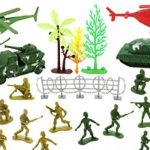
While it’s not clear that war toys promote a culture of war, it is clear that the reverse is true, i.e. the culture of war promotes war toys.
Here is a good discussion of this.
Critics of war play frequently treat play as if it occurs in such a social vacuum, with little consideration of the broader societal context in which play happens. Social and cultural values shift with time and it is foolhardy to think that toys and play will not follow these trends. Increasing levels of aggression within toys have to be seen as part of a wider trend within society towards desensitisation of violence. Today, violence is brought ever closer to home through the intensity of round-the-clock news footage of armed conflict and incidents of terrorism, and the use of cultures of fear by world leaders to sustain particular (geo)political ideologies.
When reflecting upon the trend reported in the study, economic factors also have to be taken into consideration. Toy companies have to produce a saleable product – and this tends to be a product reflective of wider societal trends. With the drive towards franchising and diversification of target audiences as marketing strategies (as seen with the Lego brand, prompting the likes of Star Wars, Lord of the Rings and Harry Potter themed play sets, and the targeting of adult consumers) digital media is leading developments in non-digital media. Here we are seeing trends towards fantasy scenarios centred on overcoming imaginary evils.
Scholars have shown this is part of wider cultures of fear within the post 9/11 era. Toys and digital media are, therefore, reflecting the social and political life of their time and contributing to the prevailing geopolitical climate. Childhood is not a sphere of innocence magically shielded from the wider world; it plays an active part in shaping it.